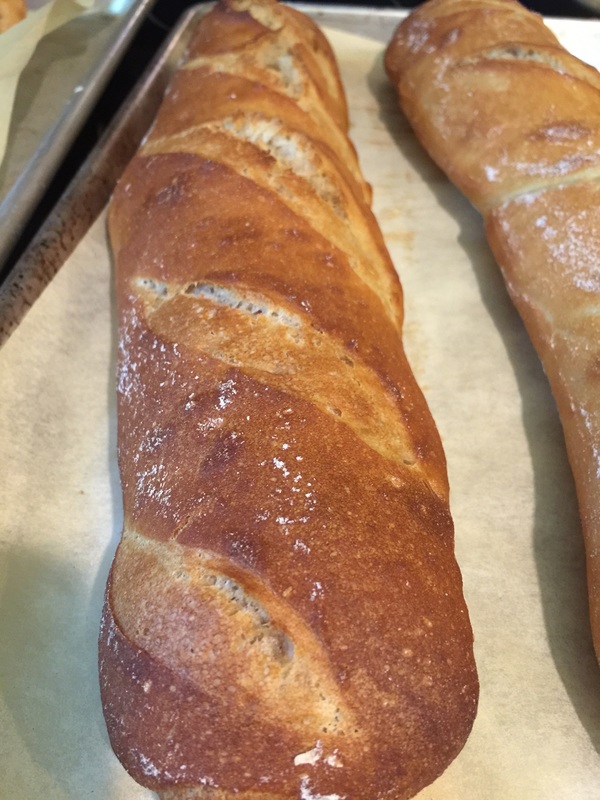|
After taking the baguette class at King Arthur Flour a few weeks ago, I decided to brave the challenge and make them at home. Baguettes are a simple, lean dough made from flour, water, salt and yeast. However, to get really beautiful, tasty baguettes, the devil is in the technique.
I liked the King Arthur Flour formula that we made in class, but Jeffrey Hamelman offers a much more detailed version of this formula in his Bread book. I cleaned my granite countertop throughly and started playing with bread dough. What I like about this formula is that once you complete your fermentation (and I did try to fold by hand and not by mixer despite the wetness of the dough) at room temperature, you can divide the dough into weighed pieces and stick them in the fridge until you are ready to shape, proof and bake them (up to 18 hours). So I made the dough the day before, weighed out 4 loaves and stuck them into the fridge. My poor fridge looked like a science experiment between the containers with bread dough, starter, homemade coconut milk kefir, and homemade evaporated milk (other projects/other blogs). But early the next morning, I woke up and started shaping loaves. What I very quickly learned about shaping 1lb baguette loaves to be baked in a home oven is that you can't shape them exactly the same way you would a baguette for a commercial oven. You would have to 1/2 the weight to get them so thin. Well, that meant I could handle them less in the shaping process, which made it easier to get a consistent shape. I had only one messy loaf, and that was a result of transfer, not shaping. So next time I have two options - make 8 1/2 lb loaves - or keep making 4 thicker 1lb loaves. Truth is, I kind of liked them a little thicker and felt that you could do more with them, but I may experiment and see either way. I baked all four loaves at the same time in a 525F degree oven. I baked the first two on a baking tray on top of a steel in the middle rack and the second two on a pre-heated tray on the top rack. That worked out because all four loaves baked evenly. The other major difference in these loaves and what we did in the KAF class is the flour. For these, I used a stone milled heritage wheat called Bolted Red Fife from Sunrise Flour Mill. This wheat is something special. It's an heirloom wheat variety that is not mass produced. This kind of heritage flour is know to be easily digestible and friendly to people with gluten sensitivities. This is what they say about it on their website, " Modern wheat is very different from the wheat our ancestors ate. The developments in grain have made it difficult for some people to digest, but that doesn't necessarily mean they need to change to a gluten-free diet. If you've experienced negative health effects as the result of gluten intolerance, but miss your morning toast or favorite dessert, Sunrise Flour Mill's Heritage Flour products may be the answer. These superior flours aren't just for those who experience problems with gluten. Many people use Heritage Wheat because it truly tastes like wheat and results in delicious pastries, breads, pasta and pizza." I bought this wheat because it was more nutrient dense and healthier. I also bought it because it was stone milled and organic. Let me tell you - I will keep buying it for the taste! It tastes fantastic! When I cut into my sample loaf (the one that didn't shape properly), and tried it - I couldn't stop at one taste. I had three pieces right away because it was THAT good! It's not the same sparkling white as many of the other commercially available flours. In fact, it has a reddish brown color to it when baked that is easily mistakable for whole wheat - but don't let the color fool you, this is a light, airy flour that makes a fantastic baguette!
0 Comments
Your comment will be posted after it is approved.
Leave a Reply. |
DebI'm a home cook with a lifelong passion for learning, exploring and experimenting in my kitchen. You can find me at @Debs1 on Twitter and @Debs121212 on Instagram. Categories
All
Archives
July 2020
This website uses marketing and tracking technologies. Opting out of this will opt you out of all cookies, except for those needed to run the website. Note that some products may not work as well without tracking cookies. Opt Out of Cookies |




 RSS Feed
RSS Feed
